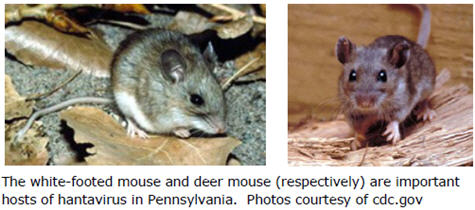Hantavirus
Other Names: Hantavirus pulmonary syndrome, hemorrhagic fever with renal syndrome
Cause
There are many different species of rodent-borne hantaviruses that cause hemorrhagic fever in humans. Hantavirus was first isolated in 1976 when there was an outbreak of hemorrhagic fever in United Nations troops in Korea.
Significance
Humans can become severely ill when infected with hantavirus. Old world hantaviruses (those that occur in Africa, Asia, and Europe) cause hemorrhagic fever with renal syndrome (HFRS), while new world (the western hemisphere) species cause hantavirus pulmonary syndrome (HPS). HPS is a severe and sometimes fatal respiratory disease that can occur in previously healthy individuals. People who work in construction, pest control, work under houses, clean areas where rodents live, or anyone who may come in contact with rodent feces, urine, or saliva may be at risk. To avoid this disease people should minimize contact with rodents by preventing rodent infestations. People who must work in areas where rodent nests exist must take precautions. It is especially important to provide adequate ventilation or wear personal protection such as safety glasses, masks, and gloves. It is also important to prevent stirring up rodent excrement when cleaning (do not vacuum or sweep to clean up after rodents).

Species Affected
Rats, mice, and voles are the natural hosts for hantaviruses. Specifically, the species known to carry hantavirus in the United States include the deer mouse, white-footed mouse, rice rat, and cotton rat. Little is known about hantavirus in other animal species; although there is evidence that infections may occur in wild and domestic animals including coyotes, cats, and, dogs.
Distribution
Hantaviruses are found in Europe, Asia, and North and South America. In the United States most human cases of hantavirus occur in the western part of the country although there have been human cases reported in Pennsylvania, New York, Maine, Virginia, West Virginia, North Carolina, Florida, Louisiana, Iowa, Minnesota, Wisconsin, Illinois, and Indiana.. In 1993 there was an outbreak of hantavirus in the southwestern United States. Hantavirus was the cause of disease in a Clearfield County resident in 2007.
Transmission
Infected rodents shed hantavirus in their saliva, urine, and feces. The virus is likely transmitted from rodent to rodent during aggressive interactions. Greater rodent population densities and conditions that congregate them, such as food sources, allow more opportunities for transmission. Other mammal species may become infected by coming into contact with infected rodent hosts. Humans usually become infected by inhaling aerosolized rodent excretions containing virus particles. Humans may also acquire the virus via the bite of an infected animal, by coming into contact with rodent urine, feces, or saliva, or by ingesting food contaminated with rodent urine, feces, or saliva containing the virus. Human to human transmission of hantavirus is very rare. While other mammals such as cats and dogs may become infected with hantavirus, they are not known to transmit the virus to other animals or humans.
Clinical Signs
Rodents carrying hantavirus show no signs of clinical illness, although they remain chronically infected. Little is known about how this disease affects other animals.
Diagnosis
Blood tests are used to diagnose hantavirus in humans and animals.
Treatment
There is no specific treatment for hantavirus in animals or humans.
Management/Prevention
Rodent control is the main form of management for hantavirus. Rodents should be kept out of human dwellings, and people should avoid coming into contact with rodents, their nests, and their excrement.
Suggested Reading
Centers for Disease Control and Prevention (CDC). 2011. Hantavirus. http://www.cdc.gov/hantavirus/.
Mills, J. N., and J. E. Childs. 2001. Rodent-Borne Hemorrhagic Fever Viruses. Pages 254-270 in E. S. Williams and I. K. Barker, editors. Infectious diseases of wild mammals. Iowa State University Press, Ames, Iowa, USA.